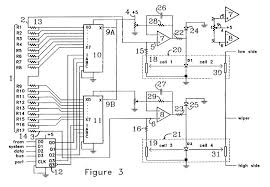Matador
Well-known member
I was looking over the schematics to the Mesa Boogie Triaxis, which was one of the first all-tube preamps that could be controlled via MIDI.
They accomplished this by replacing the traditional controls in the tube circuits with dual LDR's, and wrapping one side of each LDR within the feedback path of an op-amp to linearize the IV curve. Mesa's patent just expired last month, so I don't feel bad about posting the circuit here!

So the opamp adjusts the drive of the LED until the non-inverting terminal equals 2.5V (the adjustment of the pot at the inverting terminal), which means the resistance of the fixed resistors at the analog switches is equal to the resistance of the LDR at that brightness (and since the LDR is a dual LDR, the resistance of the 'other side' should be equal as well).
However dual LDR's are extremely hard to find: is there any reason why the LDR can't be replaced with a dual JFET or MOSFET? The op-amp could drive the gate and adjust the gate drive to make the resistances between the two devices match as before.
The one limitation I can think of: most JFET's can only have 40V or so across the SD junction, and MOSFETS have a parasitic diode that prevents the source from rising above the drain. Hence these devices may not work in cases like the midrange of a Fender tone stack.
Is there nay reason this can't work with regular dual FET transistors?
They accomplished this by replacing the traditional controls in the tube circuits with dual LDR's, and wrapping one side of each LDR within the feedback path of an op-amp to linearize the IV curve. Mesa's patent just expired last month, so I don't feel bad about posting the circuit here!
So the opamp adjusts the drive of the LED until the non-inverting terminal equals 2.5V (the adjustment of the pot at the inverting terminal), which means the resistance of the fixed resistors at the analog switches is equal to the resistance of the LDR at that brightness (and since the LDR is a dual LDR, the resistance of the 'other side' should be equal as well).
However dual LDR's are extremely hard to find: is there any reason why the LDR can't be replaced with a dual JFET or MOSFET? The op-amp could drive the gate and adjust the gate drive to make the resistances between the two devices match as before.
The one limitation I can think of: most JFET's can only have 40V or so across the SD junction, and MOSFETS have a parasitic diode that prevents the source from rising above the drain. Hence these devices may not work in cases like the midrange of a Fender tone stack.
Is there nay reason this can't work with regular dual FET transistors?



























![Electronics Soldering Iron Kit, [Upgraded] Soldering Iron 110V 90W LCD Digital Portable Soldering Kit 180-480℃(356-896℉), Welding Tool with ON/OFF Switch, Auto-sleep, Thermostatic Design](https://m.media-amazon.com/images/I/41gRDnlyfJS._SL500_.jpg)





